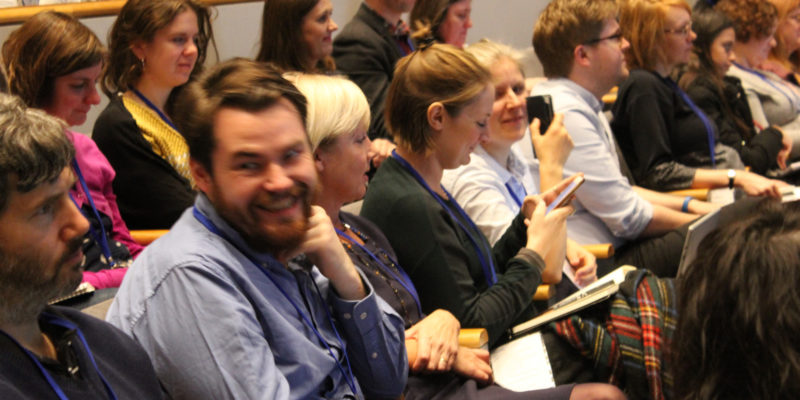
Natàlia was part of our team of bursary-funded volunteers who helped to make the Museums+Tech 2018 conference our most successful yet. Here, Natàlia reflects on the presentations of the day.
On 19 October, I was lucky enough to volunteer at the MCG Museums+Tech 2018 conference at the National Gallery, London. A plethora of inspiring speakers shed light on how digital can be used in the cultural sector in new ways. Collaborating, understanding working rhythms and taking ethical considerations into account were hot topics throughout. Read on to discover key ideas taken from my favourite guest speakers!
Identify your rhythm
Matt Locke, founder of Storythings, set an underlying concept that trickled through all other presentations. Matt considered that before embarking on any digital project, an institution must understand its rhythm. That is, the deeper time and cultural structure defining how work gets done in a particular industry. Understanding rhythm can facilitate coordination with other industries working at a different pace and in a different cultural frame.
It was interesting to see how other speakers later on, perhaps accidentally, illustrated the importance of understanding rhythms. Senior Digital Manager Elizabeth Bullock discussed the collaboration between English Heritage and Google Arts and Culture. Partnering with such a large tech company was beneficial in terms of PR and outreach of the project, but it did add the logistical difficulties of adapting to the faster working pace and culture of a tech company that hadn’t worked with cultural institutions before.

Image: Alexia Charoud
Work with your audience
It was widely discussed that museums should imbed audience-input into decision making processes; be it to create new content or understand visitor perceptions. Katherine Biggs, Navjot Mangat and Joanna Salter, working at Royal Museums Greenwich, provided an excellent illustration of what successful audience participation looks like.
During the “re.think” project at the Royal Maritime Museum of Greenwich, visitors engaged with emotive topics and exhibits. They could vote on hot topics or write personal accounts, and these responses were used for following exhibitions and online. Artist in residence Stefanie Posavec also analysed visitor collected data to create artworks, allowing visitors to transparently see how their input was being used. These approaches provided the audience with a sense of ownership of the collection. In addition, highly-observational testing with visitors enabled museum staff to understand how content was being perceived. Museums should not assume audience perceptions but rather work closely with them to develop more meaningful exhibitions.
In addition, museums should take advantage of the unique learning space they can provide for a variety of audiences. At University of Cambridge Museums, Kate Noble explained, “Maker Spaces” should be encouraged. The museum allowed visitors to learn about technology by playing with it and creating their own objects. Feedback demonstrated a high level of enjoyment, with an increased self-confidence and bettered problem solving skills. Resources and budgets are often limited, but through this project the museum discovered 3D printers hiding somewhere in the building, and managed to engage with staff who were keen to learn as much as visitors.
Consider unconventional partners
Finding partnerships beyond the cultural sector can prove widely beneficial. Michal Čudrnák and Dr Johnathan Prior, lecturer in Human Geography, presented their sound-walking experience at the Slovak National Gallery. Combining the expertise of lecturers, voice actors and curators, the museum provided an immersive experience that enhanced the content on display and educated visitors through story-telling. Sound-based projects require low budgets, and they can always be enhanced by location-sensitive apps should more funding emerge.

Image: Alexia Charoud
Owen Gower presented other advantages of looking beyond predicted partners. Dr Jenner’s House, Museum and Garden collaborated with game developers to make a 3D virtual experience presenting the site as it would have been in 1823. Audiences could learn and enjoy the virtual experience using a PlayStation remotely. A positive outcome, game developers became extremely involved with the historical research process and curiously chose different objects to scan which were not expected by curators. Welcoming outsiders and working with them can allow for unforeseen storytelling of your collections.
Social Media is a bittersweet tool
A commended highlight of the conference was the contribution of Lauren Bassam, current Assistant Curator at V&A Dundee. Showcasing the success of Instagram account @lgbt_history, the talk demonstrated how such an image-oriented social media platform can be used as an entry point to archival materials, sparking conversations among new users and creating unconventional archivists. With Instagram it becomes easy to discuss stories that are often tricky to tell in the space of the archive.
There are of course, as PhD Candidate Jon Pratty pointed out, ethical issues involved in using social media sites. The valuable content that is shared on Social Media benefits engagement and outreach, but it implies a dependence on private companies that, as we have seen in many occasions, become obsolete. Sustainable alternatives would involve methods of decentralisation, where data is not traded with a monopolising data-driven company but rather divided between local and subject infrastructures that can control its usage (i.e. Tim Berners-Lee SoLID).
These speakers and many others provided plenty of food for thought throughout the conference. It is clear that welcoming digital into the cultural sector can be highly beneficial. Ultimately, the key of a successful digital project is to align it with the core objectives of an institution, turning digital into a tool rather than an objective in itself. With case studies like the above, one can only wonder what exciting projects lie ahead! I hope to see you in the next MCG Museums+Tech conference.

